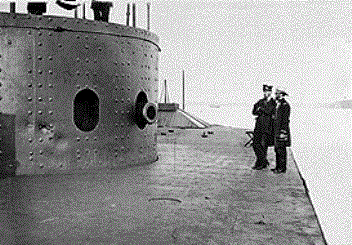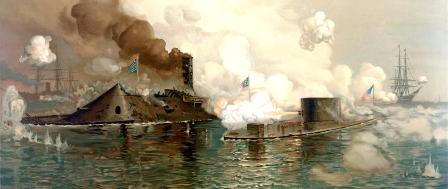| Definition of Ironclads, the Monitor and the Merrimack
Definition: What were the Ironclads used in the Civil War? What was the Monitor and the Merrimack? Ironclads were steam-propelled naval vessels (warships) that had the parts, above water, covered and protected by large plates of iron or steel that were thick and strong to resist heavy shot. The Battle of the Ironclads, also referred to as the Battle of Hampton Roads, involved the USS Monitor an iron-hulled (ironclad) steamship belonging to the Union Navy and the Merrimack, an ironclad Confederacy warship. The Battle of the Monitor and Merrimack was one of the most important naval battles of the American Civil War. The Ironclads: Monitor vs Merrimack
Abraham Lincoln was the 16th American President who served in office from March 4, 1861 to April 15, 1865. One of the key events during his presidency was the Civil War battles involving the Ironclads and the Monitor vs Merrimack (also spelt as Merrimac). |
|
| Ironclads before the Civil War
The development of the Ironclads began during the Crimean War (1853 - 1856) between Great Britain and France in which ironclad barges were mounted with heavy guns. This development sparked off a naval arms race and in 1859 the French completed the first ironclad warship. The construction of Ironclads, the new type of warships with iron hulls, led to the wide use of armor to protect the top part of the warship and the deck from artillery shells (cannon). Ironclads in the Civil War
Neither the North nor the South was prepared for the Civil War. At the start of the Civil War the Union navy had only about 40 ships, and the Confederacy had even less. The Union had the shipbuilding industry and were able to commission the building of new, wooden ships. The Confederacy employed the strategy of making the most of the ships that they did have, as powerful, effective and as formidable as possible. This new era in warfare not only brought the Ironclads but also the use of submarines, torpedoes, rockets, land mines, and even hot air balloons - refer to Civil War Inventions and Technology. | Battle of the Ironclads: The Monitor and Merrimack 
|
| | | Photo of the Monitor Ironclad
 (check out the damage caused by a cannonball
on the gun turret to the left of the photograph) | Ironclads: The Monitor and the Merrimack
The Confederacy challenged the Union navy by the use of the latest technology, the ironclads. Spies reported the intentions of the Confederates and the Union also started to build ironclads. The first battle between ironclads in the Civil War was the Battle of the Ironclads between the Union ironclad (the Monitor) and the Confederacy ironclad (the Merrimack). Ironclads: The Monitor and the two "Soda Bottles"
The Monitor ironclad, with its unique, round, revolving turret, was designed by the inventor John Ericsson. It was built in Brooklyn in just over 100 days and cost the Union $275,000. The Monitor ironclad measured 179 ft (54.6 m) in length and was 41 ft 6 in (12.6 m) wide. It was propelled by a vibrating-lever steam engine and a propeller. The Monitor was armed with two 11-inch smoothbore Dahlgren guns, that were nicknamed "soda bottles" because of their shape. The Monitor had a layer of heavy metal armor plated onto its outer hull (called belt armor), a round armor plated gun turret, an armor covered Pilothouse from where the Ironclad was controlled by the ship's pilot. The Monitor Ironclad was designed for a crew of about 50 men. |
Ironclads: The Merrimack (Renamed Virginia)
The Merrimack ironclad was originally a Union steam frigate that was captured by the Confederacy, converted into an ironclad vessel and renamed the Virginia. The Merrimack was the first ironclad built by the Confederacy and was designed as a casemate ironclad ram by the Lt. John Mercer Brooke. The Confederates replaced everything above the waterline with a casemate of heavy timbers covered by four inches of iron plating. The Merrimack ironclad measured 275 ft (84 m) in length and was 38 ft 5 in (12.6 m) wide. It was propelled by a both sail and a steam engine. The Merrimack was armed with ten 8-inch guns, two 10-inch pivot-mounted rifles at each end, and six 9-inch smoothbore guns. It had a layer of heavy metal armor plated onto its outer hull (called belt armor), an armor plated gun turret, an armor covered Pilothouse from where the Merrimack Ironclad was controlled by the ship's pilot. An iron ram was affixed to her bow, allowing the ship itself to be employed as a deadly weapon. |
The Ironclads: The Battle of Hampton Roads
The Merrimack Ironclad was a crude design, underpowered but still highly superior to wooden ships which was proved when on her first combat mission. The Merrimack, with a small fleet of accompanying ships, attempted to break the Union Blockade by engaging the Union fleet at the Battle of Hampton Roads. Hampton Roads, a natural harbor, was a major anchorage point with extensive shipyards and harbor facilities. Newport News and Hampton on the north shore and Norfolk and Portsmouth on the south shore. On March 8, 1862, attempting to break the Union Blockade, the Merrimack attacked the Union fleet at anchor near Fortress Monroe and sank the Cumberland and the Congress. The Merrimack returned to attack the Minnesota the next day but instead she was faced with the Ironclad Monitor and the Battle of the Ironclads. |  The Ironclads: The Battle of Hampton Roads |
The Battle of the Ironclads: Monitor vs Merrimack
The Monitor and the Merrimack met in what became famously called the Battle of the Ironclads. Civil War for Kids: Monitor vs Merrimack, the Battle of the Ironclads Fact Sheet | | Facts for Kids | Facts and Information | | Battle of the Ironclads Fact 1 | The Monitor and Merrimack fought the first engagement between ironclad ships. | | | | Battle of the Ironclads Fact 2 | The Battle of the Ironclads was fought on March 3, 1862 | | | | Battle of the Ironclads Fact 3 | The location of the Battle of the Ironclads was off Sewell's Point (modern-day Norfolk), near the mouth of Hampton Roads, Virginia | | | | Battle of the Ironclads Fact 4 | The Merrimac, was under the command of Lt. Catesby Jones and the Monitor was commanded by Lt. John L. Worden. | | | | Battle of the Ironclads Fact 5 | The design of the Merrimac was described as resembling "a floating barn roof" and given the nicknames of "The Rebel Monster" and "Iron Coffin" | | | | Battle of the Ironclads Fact 6 | The design of the Monitor was described as resembling "a Yankee Cheese Box on a raft." | | | | Battle of the Ironclads Fact 7 | During the Battle of the Ironclads, the Monitor always tried to protect the Minnesota. The smaller warship was the Monitor, which was faster and more maneuverable than the slower Merrimack | | | | Battle of the Ironclads Fact 8 | The Ironclads circled each other at extremely close quarters during the battle, inflicting damage on each other, but the cannonballs 'bounced off' the armor covered vessels | | | | Battle of the Ironclads Fact 9 | The firing was ineffective as there had been little time to train either of the crews. The Merrimack had not expected to fight another Ironclad warship, so its guns were supplied only with shell rather than armor-piercing shot. Monitor's guns did not provide the projectile with sufficient momentum to penetrate The Merrimack's armor | | | | Battle of the Ironclads Fact 10 | The pilothouse of the Monitor took a hit and Lt. John L. Worden was temporarily blinded looking through the viewing slits, and caught by flying iron splinters | | | | Battle of the Ironclads Fact 11 | The Monitor then retreated to waters too shallow for the Merrimack to navigate in order to attend to the injuries of Lt. John L. Worden | | | | Battle of the Ironclads Fact 12 | The battle of the Ironclads had raged for nearly four hours. Neither warship was destroyed and the result of the battle was a stalemate | | | | Battle of the Ironclads Fact 13 | The Merrimac was eventually destroyed due to explosion off Craney Island on May 11, 1862. The Monitor was lost during a heavy storm on December 31, 1862 | | | | Battle of the Ironclads Fact 14 | The Ironclads became obsolete with the introduction of the all-metal warship construction (1870–90) | | | | Battle of the Ironclads Fact 15 | The development of the Ironclads also led to the use of Submarines and torpedoes | | | | Facts for Kids | Facts and Information: Monitor vs Merrimack | 
Civil War for Kids: Monitor vs Merrimack, the Battle of the Ironclads Fact Sheet |
Ironclads - President Abraham Lincoln Video
The article on the Ironclads provides an overview of one of the major innovations in his presidential term in office. The following Abraham Lincoln video will give you additional important facts and dates about the political events experienced by the 16th American President whose presidency spanned from March 4, 1861 to April 15, 1865. | | |
| |
|